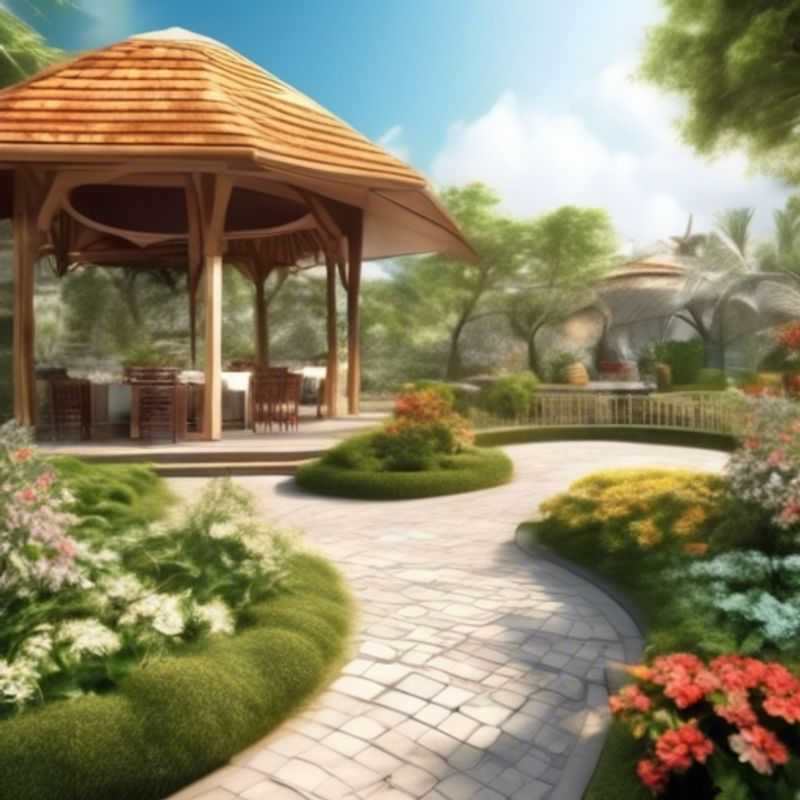Top Things to Know Before Buying The Garden Spot

Top Things to Know Before Buying a Garden Spot: Essential Considerations for Gardeners
Before diving into the world of garden spots, there are some crucial considerations to ensure you make the right choice for your outdoor space. Let's delve into the key aspects you should explore before purchasing:
Measure the available space in your garden. This is a fundamental step. Accurately measure the area where you plan to place the Garden Spot to ensure it fits comfortably and doesn't obstruct walkways or other features.
Check the weight capacity.

Measure Your Garden: Ensuring the Perfect Fit for Your Garden Spot
Before you purchase a Garden Spot, measure the area in your garden where you want to place it. This is crucial for a successful installation. A tape measure is all you need for this task.
Measure the length and width of the area you have chosen, accounting for any obstacles like trees or fences. Don't forget to measure the height of the area if your Garden Spot is designed to be elevated.
Compare your measurements to the dimensions of the Garden Spot you are considering. You can find this information on the product website or packaging. Ensure that the Garden Spot will comfortably fit within the space you have, leaving some room for access and maneuvering.
You can also sketch out a plan of your garden on paper to help you visualize the Garden Spot's placement. This will help you decide if you need to adjust the size or placement of the Garden Spot for optimal use.
You should also consider any existing features in your garden, such as pathways, water sources, or electrical outlets. Ensure these features are accessible after installing your Garden Spot and won't interfere with its operation.
This simple measurement process will ensure that the Garden Spot is a perfect fit for your garden. Remember to double-check your measurements and consider any potential obstacles before making your purchase.

Weight Capacity Check: Ensuring Your Product Can Handle the Load
Weight capacity is a crucial factor to consider when choosing any product, especially those designed to support or hold items. Understanding the weight capacity of a product is essential for ensuring its safety and effectiveness.
For example, when choosing a shelf, consider the weight of the items you intend to store on it. Ensure the shelf's weight capacity is sufficient to support the total weight of the objects. Similarly, with furniture, assess the weight capacity of chairs, tables, and beds to make sure they can handle the expected weight.
Exceeding a product's weight capacity can lead to damage, instability, and potential safety hazards. It can cause the product to break, collapse, or malfunction, creating a risk of injury or property damage. Always err on the side of caution and choose products with a weight capacity that comfortably exceeds the anticipated load.
Check the product's specifications or consult with the manufacturer for accurate weight capacity information. Always prioritize safety and choose products that meet or exceed your needs in terms of weight capacity.

Building for the Long Haul: Reviewing Construction Materials for Durability and Weather Resistance
Durability and weather resistance are crucial aspects of any construction project. Selecting the right materials can significantly impact the longevity and performance of your building. Here’s a quick guide to help you make informed decisions.
Foundations: Concrete is the most common material for foundations due to its strength and durability. Ensure proper reinforcement with steel bars for added resilience. Consider using waterproof concrete additives for areas prone to moisture.
Walls: Brick, concrete block, and wood are popular choices for walls. Brick offers good insulation and durability but can be expensive. Concrete blocks are cost-effective and provide good strength. Wood is lightweight and easy to work with but requires proper treatment for weather resistance.
Roofing: Asphalt shingles are a cost-effective option, while metal roofing offers exceptional durability and weather resistance. Consider your budget and local climate when choosing a roofing material.
Windows and Doors: Double- or triple-paned windows offer better energy efficiency and reduce heat loss. Choose windows with low-E coatings to reflect heat away. Doors should be weather-stripped and well-insulated for optimal performance. Consider energy-efficient doors made from fiberglass or composite materials.
Insulation: Proper insulation is vital for energy efficiency and comfort. Choose insulation materials that are effective for your climate. Fiberglass, cellulose, and spray foam are common options.
Exterior Finishes: For siding, consider vinyl, fiber cement, or brick. Vinyl is affordable and low maintenance, while fiber cement offers durability and fire resistance. Brick provides a classic look and excellent weather protection.
Don't forget to factor in maintenance costs when selecting materials. Regular upkeep will extend the life of your construction project.
Remember, this is just a brief overview. Thorough research and consultation with a qualified professional are essential for making the right material choices for your specific project.

Don't Buy Before You Build: Understanding Assembly Processes and Tool Needs
Before buying any product requiring assembly, take time to understand the process and tools needed. This helps avoid costly mistakes and ensures a smooth experience. Carefully examine the product description, including assembly instructions and required tools. This might involve reading online reviews or watching videos for insights. Check for recommended tools, ensuring you have them or can easily acquire them. Consider whether you have the necessary space and time for assembly. If not, professional assembly services might be a good option. Remember, a well-informed purchase leads to a satisfying assembly experience.

Don't Get Caught Without Coverage: Verifying Your Warranty Details
Before purchasing any product, it's crucial to verify the warranty details. This information outlines the manufacturer's commitment to repair or replace defective products within a specific timeframe. Understanding the warranty specifics can save you time and money in the long run.
Start by reading the warranty document carefully. Pay close attention to the duration of the warranty, coverage specifics, and any exclusions. Note any limitations on parts or labor covered, as well as any fees associated with repairs or replacements. Some warranties may require product registration, which can be done online or via mail.
Keep your warranty information in a safe and accessible place. This could include a dedicated folder, a digital file, or a note on your phone. Retain your purchase receipt as it often serves as proof of purchase and helps verify the warranty period.
Contact the manufacturer directly if you have questions about the warranty or encounter a repair or replacement issue. They can provide clarification and assistance with navigating the warranty process. Remember to be polite and have your product information readily available.

Unlocking Customer Insights: How to Use Reviews to Gauge Product Quality
Customer reviews are a powerful resource for gauging the quality and user experience of a product. By analyzing reviews, you can gain valuable insights into both the strengths and weaknesses of a product. This information can be invaluable in making informed purchasing decisions, identifying areas for improvement, and gaining a competitive advantage.
When researching customer reviews, it's crucial to focus on authenticity and relevance. Look for reviews that provide specific details about the product's features, performance, and overall experience. Consider the reviewer's profile, purchase history, and any potential biases that might influence their feedback.
Pay attention to the overall sentiment expressed in the reviews. Are they positive, negative, or mixed? Look for common themes and patterns that emerge from the reviews. Identifying recurring positive or negative feedback can help pinpoint key product strengths and weaknesses.
Analyze the language used in the reviews. Positive reviews often use words like "excellent," "amazing," or "highly recommend." Negative reviews might contain words like "disappointed," "defective," or "unusable." By analyzing the language, you can gain a deeper understanding of customer sentiment.
Remember to consider the context of the reviews. For example, a review written by a long-time customer might be more valuable than a review from a first-time buyer. Additionally, pay attention to the date of the reviews to see if they reflect recent changes in the product or the company's policies.
Don't solely rely on free online reviews. Consider conducting your own customer surveys or running focus groups. This allows you to collect targeted feedback directly from your customers, providing valuable insights into their specific needs and preferences.
By carefully researching customer reviews and analyzing the insights they provide, you can make informed decisions about product development, marketing, and customer service strategies. This data can help you improve your products, enhance customer satisfaction, and gain a competitive edge.

Outdoor Aesthetics: Choosing the Right Design for Your Space
When designing your outdoor space, it's crucial to consider the aesthetic design to match the style of your existing surroundings. This creates a cohesive and visually appealing environment. Matching the style of your home, garden, or landscaping will create a seamless transition between indoor and outdoor spaces.
Here are some key elements to consider when designing your outdoor space:
Color Palette: Choose colors that complement your existing home and landscape. For example, if your home has a warm, earthy tone, use natural colors like browns, greens, and yellows for your outdoor space. If your home has a modern, minimalist aesthetic, consider using clean lines and neutral colors like gray, white, and black.
Materials: Select materials that are durable and weather-resistant. For example, use natural stone for walkways and patios, wood for furniture, and metal for accents. Consider the overall style you're aiming for - rustic, modern, or traditional - and choose materials that align with that vision.
Lighting: Lighting plays a crucial role in creating ambiance and safety. Consider incorporating different types of lighting, such as string lights, lanterns, and spotlights, to create a warm and inviting atmosphere.
Plants and Flowers: Incorporate plants and flowers that thrive in your climate and complement your chosen color scheme. Consider using a variety of textures and heights to create visual interest.
By taking these factors into account, you can create a beautiful and functional outdoor space that seamlessly blends with your existing style. Don't forget to consider the overall purpose of your outdoor space, whether it's for entertaining, relaxation, or a combination of both. This will help guide your design decisions. Remember, the goal is to create a space that you enjoy spending time in, and that reflects your personal taste and lifestyle.
